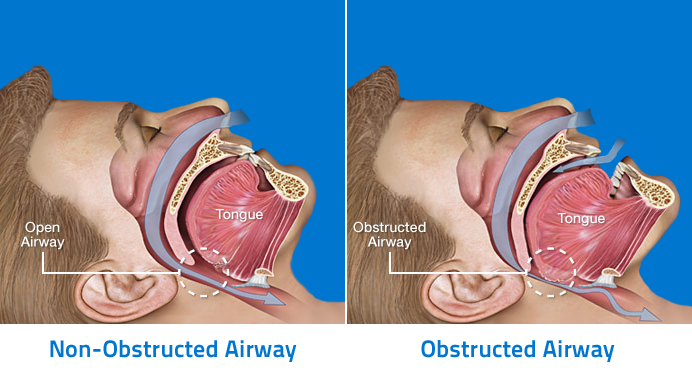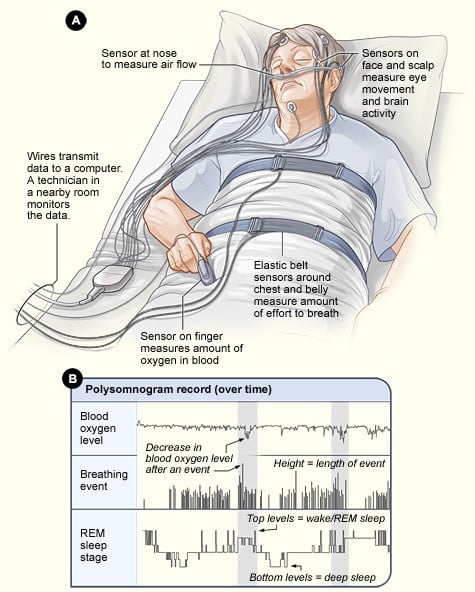In 2010, a Chinese university student was driven to murder his roommate. The reason for the murder..excessively loud snoring. The court handed down the death sentence – which was immediately suspended but could mean he will spend the rest of his life behind bars. Well, snoring can kill..but in less dramatic ways. Snoring is a common problem which if overlooked can have serious and sometimes fatal outcomes. Snoring is defined as the vibration of respiratory structures and the resulting sound due to obstructed air movement during breathing while sleeping. In some cases, the sound may be soft, but in other cases, it can be loud and unpleasant. Snoring during sleep may be a sign, or first alarm, of obstructive sleep apnea (OSA). What is Obstructive Sleep Apnea? Obstructive sleep apnea is a disorder in which the person’s breathing is repeatedly but briefly disturbed during sleep. Apnea is defined as a pause in the breathing that lasts for at least 10 seconds. The obstruction occurs when the muscles and soft tissues in the throat collapse to a level that the airway gets blocked in spite of efforts to breathe. As a result of this, there is fragmented sleep and low blood oxygen levels. This in turn may cause high blood pressure, heart diseases, diabetes mellitus, mood and memory disorders. Studies show that sleep apnea can also increase the risk of vehicular accidents. 45% of normal adults snore occasionally and 25% are habitual snorers. It is reported to affect around 90 million American adults. In Malaysia, a study conducted in 2004 reported about 47% of the adult population were habitual snorers. People who snore may have • Obstructed nasal airways • Poor muscle tone in the throat and tongue • Excessively bulky throat and/or a long soft palate & uvula  Snoring should be taken seriously as it can have both social and medical implications. It not only affects the snorer himself but can cause significant morbidity in terms of sleepless nights and fatigue for the bed partner as well. More seriously, is the fact that about 50% of loud snorers maybe having obstructive sleep apnea. What are the symptoms and signs? Sleep apnea can affect both adults and children. The known risk factors include: • Males • Overweight /obesity • Over 40 years of age • Neck circumference of over 17 inches in males and 16 inches in females • Family history of sleep apnea • Nasal conditions causing obstruction eg. Deviated nasal septum, sinusitis, allergic rhinitis • Big tonsils, large tongue and/or small mandible • Reflux disease For snorers, consult the doctor if you have any of the following complaints: • Excessive daytime sleepiness • Morning headaches • Not feeling rested after sleep • Waking up at night feeling confused • Long pauses in breathing while asleep • Recent increase in weight • Changes in level of memory, concentration or memory • Hypertension & heart diseases • History of stroke How is it diagnosed? On seeing the doctor, a detailed history, physical examination and certain specific questionnaires would determine if you need to consult a specialist. The commonest method now used to diagnose sleep apnea is by conducting a sleep study, which is also called Polysomnography. Previously, the patient was required to stay at the sleep center overnight for this study, but nowadays, this study can be conducted in the more conducive environment of his home as well. A typical sleep study shows various functions while the person is asleep including his sleep stage, respiratory effort, airflow, blood oxygen levels etc. to name a few parameters. Depending on the result of the sleep study, the person can be classified as having mild, moderate or severe sleep apnea.
Snoring should be taken seriously as it can have both social and medical implications. It not only affects the snorer himself but can cause significant morbidity in terms of sleepless nights and fatigue for the bed partner as well. More seriously, is the fact that about 50% of loud snorers maybe having obstructive sleep apnea. What are the symptoms and signs? Sleep apnea can affect both adults and children. The known risk factors include: • Males • Overweight /obesity • Over 40 years of age • Neck circumference of over 17 inches in males and 16 inches in females • Family history of sleep apnea • Nasal conditions causing obstruction eg. Deviated nasal septum, sinusitis, allergic rhinitis • Big tonsils, large tongue and/or small mandible • Reflux disease For snorers, consult the doctor if you have any of the following complaints: • Excessive daytime sleepiness • Morning headaches • Not feeling rested after sleep • Waking up at night feeling confused • Long pauses in breathing while asleep • Recent increase in weight • Changes in level of memory, concentration or memory • Hypertension & heart diseases • History of stroke How is it diagnosed? On seeing the doctor, a detailed history, physical examination and certain specific questionnaires would determine if you need to consult a specialist. The commonest method now used to diagnose sleep apnea is by conducting a sleep study, which is also called Polysomnography. Previously, the patient was required to stay at the sleep center overnight for this study, but nowadays, this study can be conducted in the more conducive environment of his home as well. A typical sleep study shows various functions while the person is asleep including his sleep stage, respiratory effort, airflow, blood oxygen levels etc. to name a few parameters. Depending on the result of the sleep study, the person can be classified as having mild, moderate or severe sleep apnea.  How is it treated? For those who are classified as having mild sleep apnea, the following lifestyle modifications may be of some help: • Weight loss • Avoid alcohol, especially about 4 hours before sleeping • Quit smoking • Avoid heavy meals atleast 3 hours before sleeping at night • Avoid drugs that can cause sedation before bedtime • Sleep on the side instead of the back • Adopt regular sleeping patterns • Elevation of the head end of the bed may help For the more severe cases, a variety of treatment options maybe offered: 1. CPAP: This is currently the gold standard treatment of patients with severe sleep apnea. It mainly consists of an apparatus which requires the patient to wear a mask while asleep. This apparatus gently blows a measured amount of air sufficient to keep the airway adequately open while the patient is asleep. 2. Surgery: Depending on the level of obstruction, an ENT surgeon can offer a range of surgeries which may deal with a blocked nose all the way down to the posterior part of the tongue. These surgeries can be done either by traditional methods or more advanced techniques involving the use of cautery, laser or radiofrequency. The basic principle is to reduce the bulk of the obstructing site/sites so as to ease breathing. In spite of these surgeries, patients may still need to use a CPAP sometimes. 3. Oral appliances: A custom-fit oral appliance can be made for patients with mild symptoms wherein the lower jaw and tongue is repositioned forward. Nowadays, several over-the-counter devices are easily available. None of these devices are registered as cures for snoring and hence are not routinely recommended. Snoring which was previously considered to be nothing more than a social hindrance is now proved to be more significant. With the wide range of medical disorders it can lead to, an awareness, early diagnosis and appropriate treatment would go a long way in the management of this common condition. Prepared by Dr Anitha Vivekanandan, Senior Lecturer, ENT Department, International Medical University
How is it treated? For those who are classified as having mild sleep apnea, the following lifestyle modifications may be of some help: • Weight loss • Avoid alcohol, especially about 4 hours before sleeping • Quit smoking • Avoid heavy meals atleast 3 hours before sleeping at night • Avoid drugs that can cause sedation before bedtime • Sleep on the side instead of the back • Adopt regular sleeping patterns • Elevation of the head end of the bed may help For the more severe cases, a variety of treatment options maybe offered: 1. CPAP: This is currently the gold standard treatment of patients with severe sleep apnea. It mainly consists of an apparatus which requires the patient to wear a mask while asleep. This apparatus gently blows a measured amount of air sufficient to keep the airway adequately open while the patient is asleep. 2. Surgery: Depending on the level of obstruction, an ENT surgeon can offer a range of surgeries which may deal with a blocked nose all the way down to the posterior part of the tongue. These surgeries can be done either by traditional methods or more advanced techniques involving the use of cautery, laser or radiofrequency. The basic principle is to reduce the bulk of the obstructing site/sites so as to ease breathing. In spite of these surgeries, patients may still need to use a CPAP sometimes. 3. Oral appliances: A custom-fit oral appliance can be made for patients with mild symptoms wherein the lower jaw and tongue is repositioned forward. Nowadays, several over-the-counter devices are easily available. None of these devices are registered as cures for snoring and hence are not routinely recommended. Snoring which was previously considered to be nothing more than a social hindrance is now proved to be more significant. With the wide range of medical disorders it can lead to, an awareness, early diagnosis and appropriate treatment would go a long way in the management of this common condition. Prepared by Dr Anitha Vivekanandan, Senior Lecturer, ENT Department, International Medical University









